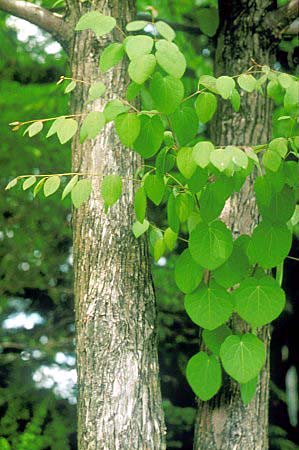
Geranium × magnificum, the purple cranesbill, is a species of hardy flowering herbaceous perennial plant in the genus Geranium, family Geraniaceae. The multiplication symbol × indicates that it is the result of hybridisation, in this case between Geranium platypetalum and Geranium ibericum. Growing into a clump 70 cm (28 in) high and broad, it has the decorative, deeply-lobed leaves typical of the genus Geranium. Violet-blue flowers with darker veins are borne relatively briefly in early summer. Extremely hardy, to below −20 °C (−4 °F), it is suitable for cultivation throughout all temperate regions. This plant has gained the Royal Horticultural Society's Award of Garden Merit.

Cercidiphyllum is a genus containing two species of plants, both commonly called katsura. They are the sole members of the monotypic family Cercidiphyllaceae. The genus is native to Japan and China and unrelated to Cercis (redbuds).

Fruit syrups or fruit molasses are concentrated fruit juices used as sweeteners.

The finback catsharks are a small family, the Proscylliidae, of ground sharks. They can be found in warm seas worldwide and are often the most numerous and common shark in tropical regions. They are generally less than 1 m in length, and are slow-moving predators that feed on bony fish and small invertebrates. Although some bear live young, the majority lay eggs with almost fully developed young; these egg cases, known as "mermaid's purses", are unique in appearance to each species.
Schumanniophyton is a genus of three species of small tree native to west Africa and belonging to the family Rubiaceae. It contains the following species and varieties:
Tropaeolum magnificum is a species of plant in the Tropaeolaceae family. It is endemic to Ecuador. Its natural habitats are subtropical or tropical moist montane forests and subtropical or tropical high-altitude grassland.

Caladium lindenii is a species of flowering plant in the family Araceae, named after Belgian botanist Jean Jules Linden.
Prunum magnificum is a species of sea snail, a marine gastropod mollusk in the family Marginellidae, the margin snails.
The genus Proscyllium is a small genus of finback catsharks in the family Proscylliidae.

Scaritinae is a subfamily of beetles in the family Carabidae, containing the following genera:
Carenum is a genus of beetles in the family Carabidae, containing the following species:

Chlorion is a genus of Hymenoptera of the Sphecidae family of wasps.
Dysoxylum magnificum is a tree in the family Meliaceae. The specific epithet magnificum is from the Latin meaning "magnificent".
Carenum imitator is a species of ground beetle in the subfamily Scaritinae. It was described by Sloane in 1897.
Carenum brevicolle is a species of ground beetle in the subfamily Scaritinae. It was described by Sloane in 1894.
Carenum brevipenne is a species of ground beetle in the subfamily Scaritinae, found in Australia. It was described by William John Macleay in 1887.
Carenum janthinum is a species of ground beetle in the subfamily Scaritinae. It was described by William John Macleay in 1883.

Cercidiphyllum magnificum, known as the large-leaf katsura or magnificent katsura tree, is a species of flowering tree in the family Cercidiphyllaceae native to Honshu, Japan. It is sometimes called caramel tree for the light, sweet smell it emits during leaf fall, sometimes compared to cotton candy (candyfloss) or "freshly baked biscuits and bread". It is grown as an ornamental tree for its heart shaped leaves that in autumn turn a mixture of bright yellow, pink and orange-red.
Lamiodendron is a monotypic genus of flowering plants belonging to the family Bignoniaceae. It only consists of one species, 'Lamiodendron magnificum' 'Steenis It is also in the Tribe Tecomeae.

Anthurium magnificum is a plant in the genus Anthurium native to Colombia. Closely resembling other Anthurium species like Anthurium crystallinum, it has large, cordate leaves with prominent veining and is primarily terrestrial. Plants of the true species can be distinguished primarily by their quadrangular petioles.








